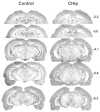Hippocampal lesions impair retention of discriminative responding based on energy state cues
- PMID: 20141284
- PMCID: PMC2850045
- DOI: 10.1037/a0018402
Hippocampal lesions impair retention of discriminative responding based on energy state cues
Abstract
The present research investigated the hypothesis that the hippocampus is involved with the control of appetitive behavior by interoceptive "hunger" and "satiety" signals. Rats were trained to solve a food deprivation intensity discrimination problem in which stimuli produced by 0-hr and 24-hr food deprivation served as discriminative cues for the delivery of sucrose pellets. For Group 0+, sucrose pellets were delivered at the conclusion of each 4-min session that took place under 0-hr food deprivation, whereas no pellets were delivered during sessions that took place when the rats had been food deprived for 24 hr. Group 24+ received the reverse discriminative contingency (i.e., they received sucrose pellets under 24-hr but not under 0-hr food deprivation). When asymptotic discrimination performance was achieved (indexed by greater incidence of food magazine approach behavior on reinforced compared with nonreinforced sessions), half of the rats in each group received hippocampal lesions, and the remaining rats in each group were designated as sham- or nonlesioned controls. Following recovery from surgery, food deprivation discrimination performance was compared for lesioned and control rats in both Groups 0+ and 24+. Discriminative responding was impaired for rats with hippocampal lesions relative to their controls. This impairment was based largely on elevated responding to nonreinforced food deprivation cues. In addition, hippocampal damage was associated with increased body weight under conditions of ad libitum feeding. The results suggest that the inhibition of appetitive behavior by energy state signals may depend, in part, on the hippocampus.
(c) 2009 APA, all rights reserved.
Figures




Similar articles
-
Western diet and the weakening of the interoceptive stimulus control of appetitive behavior.Behav Brain Res. 2016 Oct 1;312:219-30. doi: 10.1016/j.bbr.2016.06.020. Epub 2016 Jun 14. Behav Brain Res. 2016. PMID: 27312269 Free PMC article.
-
Western-style diet impairs stimulus control by food deprivation state cues: Implications for obesogenic environments.Appetite. 2015 Oct;93:13-23. doi: 10.1016/j.appet.2015.05.018. Epub 2015 May 19. Appetite. 2015. PMID: 26002280 Free PMC article.
-
Discriminative control by deprivation states and external cues in male and female rats.Physiol Behav. 2018 Feb 1;184:91-99. doi: 10.1016/j.physbeh.2017.08.019. Epub 2017 Aug 25. Physiol Behav. 2018. PMID: 28847483 Free PMC article.
-
Reframing appetitive reinforcement learning and reward valuation as effects mediated by hippocampal-dependent behavioral inhibition.Nutr Res. 2020 Jul;79:1-12. doi: 10.1016/j.nutres.2020.05.001. Epub 2020 May 13. Nutr Res. 2020. PMID: 32544728 Free PMC article. Review.
-
The nature and function of interoceptive signals to feed: toward integration of physiological and learning perspectives.Psychol Rev. 1993 Oct;100(4):640-57. doi: 10.1037/0033-295x.100.4.640. Psychol Rev. 1993. PMID: 8255952 Review.
Cited by
-
Ghrelin: A link between memory and ingestive behavior.Physiol Behav. 2016 Aug 1;162:10-7. doi: 10.1016/j.physbeh.2016.03.039. Epub 2016 Apr 9. Physiol Behav. 2016. PMID: 27072509 Free PMC article. Review.
-
Hunger, Satiety, and Their Vulnerabilities.Nutrients. 2024 Sep 6;16(17):3013. doi: 10.3390/nu16173013. Nutrients. 2024. PMID: 39275328 Free PMC article. Review.
-
Western diet and the weakening of the interoceptive stimulus control of appetitive behavior.Behav Brain Res. 2016 Oct 1;312:219-30. doi: 10.1016/j.bbr.2016.06.020. Epub 2016 Jun 14. Behav Brain Res. 2016. PMID: 27312269 Free PMC article.
-
The Cognitive Control of Eating and Body Weight: It's More Than What You "Think".Front Psychol. 2019 Feb 13;10:62. doi: 10.3389/fpsyg.2019.00062. eCollection 2019. Front Psychol. 2019. PMID: 30814963 Free PMC article. Review.
-
Gut vagal sensory signaling regulates hippocampus function through multi-order pathways.Nat Commun. 2018 Jun 5;9(1):2181. doi: 10.1038/s41467-018-04639-1. Nat Commun. 2018. PMID: 29872139 Free PMC article.
References
-
- Berthoud HR. Mind versus metabolism in the control of food intake and energy balance. Physiology & Behavior. 2004;81(5):781–793. - PubMed
-
- Chan KH, Morell JR, Jarrard LE, Davidson TL. Reconsideration of the role of the hippocampus in learned inhibition. Behavioural Brain Research. 2001;119(2):111–130. - PubMed
-
- Davidson TL. Learning about deprivation intensity stimuli. Behavioral Neuroscience. 1987;101(2):198–208. - PubMed

